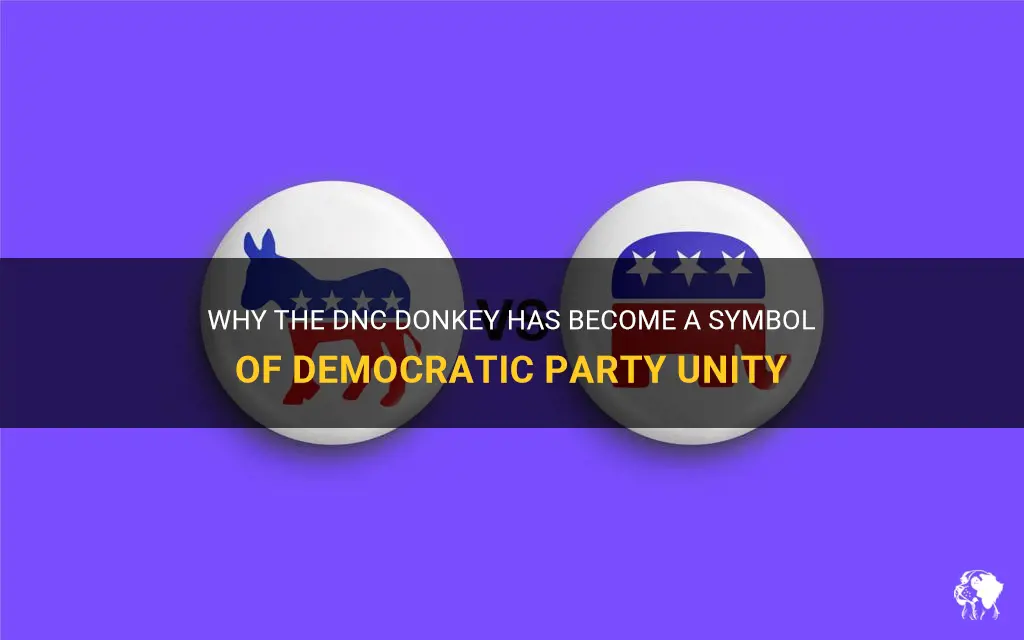
The donkey has been a long-standing symbol of the Democratic Party in the United States, but have you ever wondered why? The story behind this peculiar choice of animal goes back to the 19th century and involves a clever political cartoonist, a stubborn presidential candidate, and a historical event that forever tied the donkey to the DNC. So, sit back and let's dive into the fascinating history of why the donkey became the unofficial mascot of the Democratic Party.
| Characteristics | Values |
|---|---|
| Animal | Donkey |
| Symbol | Democratic Party |
| Political Affiliation | Democrats |
| Representation | Mainly used to depict the Democratic Party in the United States |
| History | Adopted as the symbol of the Democratic Party in the 19th century |
| Strengths | Known for their endurance and hard work |
| Weaknesses | Not as powerful as some other animals |
| Perception | Often used as a symbol of stubbornness |
| Significance | Represents the party's values of inclusivity and support for working-class Americans |
| Other Names | DNC Donkey, Democratic Donkey |
What You'll Learn
- What is the significance of the donkey as a symbol of the Democratic National Committee (DNC)?
- How did the donkey become associated with the Democratic Party in the United States?
- What are the different interpretations and meanings behind the donkey as a political symbol for the DNC?
- Are there any other political parties or organizations around the world that use a donkey as their symbol?
- Has the donkey symbol faced any controversies or criticisms regarding its use by the DNC?

What is the significance of the donkey as a symbol of the Democratic National Committee (DNC)?
The donkey has long been a symbol of the Democratic National Committee (DNC), and its significance is rooted in American political history. The donkey's association with the Democratic Party can be traced back to a famous cartoon from the 19th century.
In 1828, the Democratic candidate for president, Andrew Jackson, was often referred to as a "jackass" by his political opponents. Rather than being offended by this insult, Jackson embraced it as a symbol of strength and determination. He used the donkey symbol in his campaign, depicting himself as the embodiment of these qualities.
The donkey symbol gained further prominence in 1870 when influential political cartoonist Thomas Nast published a cartoon titled "A Live Jackass Kicking a Dead Lion." In this cartoon, the donkey symbolized the Democratic Party and was shown scaring away a lion, representing the "Tammany Tiger" - a symbol of corruption and injustice.
Nast's cartoon resonated with the public, and the donkey became firmly associated with the Democratic Party. The image of the donkey kicking the lion portrayed the Democrats as a force for progress, fighting against injustice and corruption.
Since then, the donkey has remained a symbol of the Democratic Party and the DNC. It is frequently used in campaign logos, merchandise, and party branding. The donkey symbolizes the party's values of fairness, equality, and progress. It represents the Democrats' commitment to fighting for the rights of ordinary Americans and challenging the status quo.
The donkey's significance as a symbol goes beyond its historical associations. It communicates a sense of unity and pride among Democrats, serving as a rallying point for party members and supporters. It helps to create a cohesive identity and fosters a sense of belonging.
For example, during the 2020 Democratic National Convention, the donkey symbol was prominently featured in virtual backdrops and graphics. This visual representation helped to create a cohesive and recognizable brand for the convention, despite the challenges posed by the COVID-19 pandemic.
In conclusion, the significance of the donkey as a symbol of the Democratic National Committee is rooted in its historical associations with the party's values and its role in political cartoons. The donkey represents the Democrats' commitment to fighting for fairness, equality, and progress. It serves as a cohesive symbol that unites party members and supporters, fostering a sense of pride and belonging.
Do Male Donkeys Have Nipples: Unveiling the Mystery of Donkey Anatomy
You may want to see also

How did the donkey become associated with the Democratic Party in the United States?
The donkey has long been associated with the Democratic Party in the United States, but how did this iconic symbol come to represent the party? This article will explore the origins of the donkey as a symbol for the Democratic Party and its evolution throughout history.
The association between the donkey and the Democratic Party can be traced back to the presidential campaign of Andrew Jackson in 1828. Jackson, often referred to as a "jackass" by his critics, embraced the nickname and used it to his advantage. He saw the donkey as a symbol of strength and stubbornness, traits that he believed were essential for a successful political leader.
During the 1828 campaign, political cartoonist Thomas Nast began using the donkey as a representation of Jackson and the Democratic Party in his illustrations. Nast's cartoons were widely circulated and helped solidify the association between the donkey and the Democratic Party in the public consciousness.
The donkey gained even more prominence as a symbol for the Democratic Party during the 1870s. In 1874, Nast published a cartoon titled "A Live Jackass Kicking a Dead Lion," which depicted a donkey representing the Democrats and a dead lion representing the Republican Party. This cartoon further reinforced the idea of the donkey as a symbol of strength and determination in the face of opposition.
In the early 20th century, the donkey became firmly established as the official symbol of the Democratic Party. In 1920, the Democratic National Committee adopted the donkey as its official logo. Since then, the donkey has appeared on campaign materials, signage, and other promotional materials for the Democratic Party.
The donkey's association with the Democratic Party has not always been embraced by party members. In the 1970s, some Democrats sought to distance themselves from the donkey and its perceived negative connotations. However, despite these efforts, the donkey remains a recognizable and beloved symbol of the Democratic Party.
In conclusion, the donkey became associated with the Democratic Party in the United States through a combination of political circumstances and the influence of cartoonist Thomas Nast. From its origins in the presidential campaign of Andrew Jackson to its adoption as the official symbol of the party, the donkey has become an enduring and recognizable representation of the Democratic Party and its values.
The Symbolic Meaning of Donkeys in Judaism
You may want to see also

What are the different interpretations and meanings behind the donkey as a political symbol for the DNC?
Donkeys have long been associated with the Democratic Party in the United States. The donkey has become a symbol for the Democratic National Committee (DNC), representing the party's ideals and values. However, the interpretation and meaning behind the donkey as a political symbol can vary depending on different factors such as historical context and personal perspectives.
One interpretation of the donkey as a political symbol for the DNC is that it represents the humble origins and hardworking nature of the party. The donkey is often seen as a symbol of strength and perseverance, as it has historically been a beast of burden used to carry heavy loads. This interpretation suggests that the Democratic Party represents the everyday working-class individuals who strive for a better future.
Another interpretation of the donkey as a political symbol is its association with popular political cartoons from the 19th century. The donkey first appeared as a representation of the Democratic Party in a cartoon by Thomas Nast in Harper's Weekly in 1870. In the cartoon, the donkey was labeled "Copperhead Press" and stood for the Democratic Party's opposition to the Republican Party's efforts to rebuild the country after the Civil War. This interpretation focuses on the historical context of the donkey as a political symbol and its association with the Democratic Party's stance on certain issues.
The donkey can also be seen as a symbol of progressivism and inclusivity. In recent years, the Democratic Party has embraced progressive policies and has positioned itself as the party of social justice and equality. The donkey can signify the party's commitment to advancing these values, as it is often associated with the idea of leveling the playing field and creating opportunities for all individuals.
Furthermore, the donkey as a political symbol can also be seen as a form of political branding. The donkey is a recognizable and memorable symbol that helps to distinguish the Democratic Party from other political parties. By utilizing the donkey as their symbol, the DNC can create a visual identity that resonates with its supporters and helps rally them around the party's ideals and values.
In conclusion, the donkey as a political symbol for the Democratic National Committee has various interpretations and meanings. It can represent the humble origins and hardworking nature of the party, its opposition to certain policies, its commitment to progressivism and equality, and its political branding. The interpretation and meaning behind the donkey as a political symbol can vary depending on historical context and personal perspectives. Whether seen as a symbol of strength, opposition, progressivism, or branding, the donkey remains an important representation of the Democratic Party's ideals and values.
Exploring the Biological Impossibility: Can a Donkey Engage in Reproduction with a Human?
You may want to see also

Are there any other political parties or organizations around the world that use a donkey as their symbol?
Political parties and organizations around the world often use symbols to represent their ideologies and values. One such symbol is the donkey, which has been historically associated with the Democratic Party in the United States. However, the donkey is not exclusively used by the Democratic Party and can be found in other political contexts around the world.
The origins of the donkey as a symbol for the Democratic Party in the United States can be traced back to the 1828 presidential campaign of Andrew Jackson. During that campaign, Jackson's opponents labeled him a "jackass," but instead of being offended, Jackson embraced the symbol and used it on his campaign posters. The donkey then became widely recognized as a symbol for the Democratic Party, representing their willingness to work hard and endure hardships for the betterment of the country.
While the Democratic Party in the United States is perhaps the most well-known political organization associated with the donkey symbol, there are other political parties and organizations around the world that also use the donkey as their symbol. For example, in Mexico, the Party of the Democratic Revolution (PRD) uses a donkey as its symbol. The PRD is a left-wing political party that was founded in 1989 and has since become one of Mexico's major political parties. The donkey symbolizes the party's commitment to the working class and their focus on social justice and equality.
Similarly, in the Dominican Republic, the Dominican Liberation Party (PLD) uses a donkey as its symbol. The PLD is a center-left political party that was founded in 1973 and has been in power for most of the past two decades. The donkey represents the party's determination and resilience in pursuing their agenda of economic and social progress.
In addition to political parties, there are also non-governmental organizations (NGOs) and advocacy groups around the world that use the donkey as their symbol. For example, The Donkey Sanctuary is an international animal welfare organization that works to improve the welfare of donkeys and mules worldwide. They use the donkey as their symbol to raise awareness about the often-neglected needs of these animals and advocate for their protection.
In conclusion, while the Democratic Party in the United States is most commonly associated with the donkey symbol, there are other political parties and organizations around the world that also use the donkey as their symbol. The donkey represents various values and ideologies, such as hard work, resilience, and social justice. Whether used by political parties or animal welfare organizations, the donkey symbol serves as a powerful representation of different causes and movements around the world.
Delving into the Toxicity of Donkey Tail Plants for Dogs
You may want to see also

Has the donkey symbol faced any controversies or criticisms regarding its use by the DNC?
The donkey is a well-known symbol of the Democratic Party in the United States. It has become synonymous with the party's values and ideals. However, like any symbol or icon, the donkey has not been immune to controversies and criticisms.
One of the main controversies surrounding the use of the donkey symbol by the Democratic National Committee (DNC) is the negative connotations associated with donkeys in popular culture. Donkeys are often depicted as stubborn and unintelligent animals, which has led some critics to argue that the use of the donkey as a symbol undermines the party's credibility and intelligence. They argue that the DNC should choose a more dignified and powerful symbol to represent their values.
Another criticism of the donkey symbol is its historical origins. The donkey was first used as a symbol of the Democratic Party during the presidential campaign of Andrew Jackson in 1828. At the time, Jackson's political opponents referred to him as a "jackass," and he embraced the nickname by using a donkey as his campaign symbol. Critics argue that the choice of the donkey symbol perpetuates negative stereotypes and is not inclusive to all members of the party.
In recent years, there has also been controversy surrounding the use of the donkey symbol in political advertisements and campaigns. Some individuals argue that the use of the donkey in attack ads or negative campaign literature is disrespectful and diminishes the seriousness of political discourse. They argue that the donkey should be used in a more positive and uplifting manner to inspire voters and promote unity within the party.
Despite these controversies and criticisms, the donkey symbol continues to be widely used by the Democratic Party and is recognized by voters across the country. Supporters of the donkey argue that it represents the party's values of compassion, working-class advocacy, and progressivism. They believe that the donkey symbolizes the party's commitment to fighting for the rights and well-being of ordinary Americans.
In conclusion, while the donkey symbol has faced controversies and criticisms, it remains an enduring symbol of the Democratic Party. The negative connotations associated with donkeys and the historical origins of the symbol have led to debates about its appropriateness and inclusivity. However, supporters of the symbol argue that it represents the party's core values and ideals. Like any symbol, the donkey will continue to evolve and be interpreted differently by different people.
Understanding the Meaning and Origins of "Donkey Years
You may want to see also







